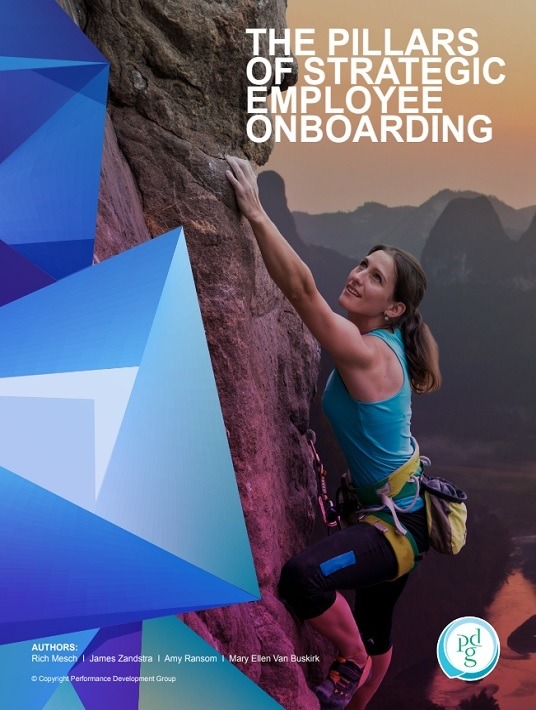Best Practices For Employee Onboarding That Boost New Hire Retention
Onboarding is critical for retaining your top talent. Retention and onboarding go hand in hand. However, simply having an onboarding program is not enough. Surveys say that 88% of organizations don’t onboard well, which leads to high turnover. Couple that with the fact that, between April and August this year, more than 18 million people quit their jobs, and it’s clear that the stakes are high and onboarding is critical.

4 Employee Onboarding Best Practices To Make Your New Top Performers Stay
1. Strategize
Before developing a new onboarding program, organizations must assess their current offering and compare it to carefully selected (and measurable) objectives. Honestly evaluate existing programs and goals for the future in terms of leading and lagging indicators of success.
Leading indicators drive lagging indicators. Leading indicators of success are whether employees know what they need to perform well, whether they’re doing it well, or being coached well. Essentially, they’re the behavioral changes leaders hope to see in their people. These ultimately impact the organization more broadly in many ways (lagging indicators), ideally positively impacting the bottom line.
Preboarding is an essential part of any onboarding plan. Training is done after an employment contract is signed and before a new hire arrives at work for the first time. Working toward these new short-term and long-term goals should begin before the new hire’s first day of work. This is a critical time for sharing things such as handbooks, benefits information, and company history.
Onboarding isn’t a one-time event either. Most organizations only focus on onboarding for a week. Still, the best programs extend through the first 90 days and, ideally, through the first year, before blending smoothly with other employee training.
2. Know
While this may seem obvious, an onboarding program’s success depends on quality learning material. Onboarding should be interactive, engaging, and customized to meet critical objectives and produce a strong return on investment. Visually appealing training is compelling, as roughly 65% of the population are visual learners (auditory learners make up 35%, and the remaining 5% are kinesthetic learners).
Moreover, we’ve found that blended learning with microlearning elements typically provides the most meaningful results. This learner-centric approach offers just-in-time training, available in easy-to-digest bits, accessible from anywhere. They allow employees to learn at their own pace and typically offer serious financial and time savings to the organization and the learner.
Ultimately, however, the best way to teach your people is unique to your organization. Your learner demographics, your organization’s culture, and your objectives will drive your process.
3. Do
After learning specific material, it is best to practice and actively engage the content, especially when new to an organization. Practice can range from simple knowledge checks to on-the-job application of specific skills. We have found that scenario-based learning is often a powerful way to teach employees.
Scenario-based learning immerses the new hire in real-life situations that require them to apply what they previously learned in a classroom (virtual or in-person) setting. This is especially powerful for new hires confronting unfamiliar situations. Scenario-based learning forces learners to apply what they learned, which further solidifies it in their minds, creating sticky learning experiences. It also causes them to be active participants in their development, as it makes connections between what they’ve learned in the abstract and what they need to do. These scenarios also drive behavioral change, facilitate decision-making, and increase critical thinking skills.
4. Refine
Great formal learning and engaging practice options are still not enough for a complete onboarding program. The most powerful onboarding (and all other learning programs, for that matter) must also include the opportunity to refine what the learner knows.
Feedback is essential for creating actual behavioral change that will drive lasting business results. It often comes in the form of adaptive learning. Artificial intelligence tailors learning materials for a specific individual based on how they’ve engaged and performed in the past learning sessions. This provides a practical and resource-efficient option, especially for larger organizations.
Coaching is also a great way to help new hires refine what they know. 87% of organizations that assign mentors during the onboarding process say this is a great way to speed up new hires’ proficiency.
Conclusion
Onboarding is critical for organizations seeking to drive their retention rates. However, most are not doing it well. In a world where people leave their jobs at a record pace, retention has never been more critical. As leaders attempt to find ways to keep their people around, they must not overlook the most powerful way to do so. Organizations with a strong onboarding strategy that includes robust learning assets, opportunities to practice, and material refined by performance will see amazing results and effectively retain their workforce.
Download the eBook The Pillars Of Strategic Employee Onboarding for insider secrets to launching a new hire training program that's adaptive, personalized, and perfectly suited for your modern workforce. Also, join the webinar to discover how onboarding drives business success!

